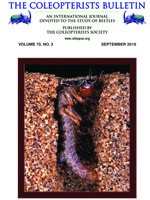Most studies on seasonal activities of Carabidae in agroecosystems are related to species of temperate regions, with very little information available for Neotropical species. In this study, a survey of adult Carabidae was conducted in three separate study areas located in the Jaboticabal and Guaíra municipalities, São Paulo, Brazil. Each study area was comprised of a forest fragment and adjacent soybean/corn crops. The objective was to determine species composition and seasonal activity of dominant species. Carabids were sampled with pitfall traps arranged along two parallel transects, each 200 m long, placed across the crops/forest boundary and extending 100 m into each habitat. Abaris basistriata Chaudoir, Calosoma granulatum Perty, Odontocheila nodicornis (Dejean), Pentacomia cupricollis (Kollar), Scarites sp. 2, Scarites sp. 3, Scarites sp. 4, Selenophorus alternans Dejean, Selenophorus seriatoporus Putzeys, and Tetracha brasiliensis (Kirby) were the dominant species. These species showed relatively few adult population peaks during the year, and the highest peaks were usually observed from November to March, coinciding with late spring and summer season.
How to translate text using browser tools
21 September 2016
Seasonal Activity of Carabidae (Coleoptera) in Forest Fragments and Crops in São Paulo, Brazil
Francisco J. Cividanes,
Terezinha M. Dos Santos Cividanes,
José C. Barbosa
ACCESS THE FULL ARTICLE

The Coleopterists Bulletin
Vol. 70 • No. 3
September 2016
Vol. 70 • No. 3
September 2016
corn
ground beetles
Neotropics
population dynamics
soybeans




